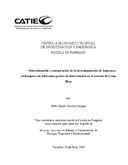| dc.description.abstract | Con el fin de conocer el efecto de las intervenciones antrópicas sobre el ciclaje de nutrientes en bosques, se evaluó la descomposición de hojarasca de bosques primarios no intervenidos (BPNI), bosques primarios bajo aprovechamiento selectivo (BPI), bosques secundarios (BS) y plantaciones puras de Virola koschnii (PL) del noreste de Costa Rica. El grado de intervención (tipo de bosque) no tuvo efecto sobre los patrones de descomposición de las especies puras, mezclas de hojarasca, ni para el material estándar durante los primeros seis meses de incubación siendo la calidad del material el factor que determinó el grado de descomposición. De todas las especies nativas evaluadas, las palmas IX Iriartea deltoidea y Welfia regia presentaron la descomposición más rápida y lenta, respectivamente dicha respuesta podría indicarnos que pertenecen a grupos funcionales distintos. Las especies de BPNI se descompusieron significativamente más rápido que las de BS y BPI. En general, las especies dominantes de los bosques bajo estudio, se catalogan como especies de lenta descomposición, debido a sus altos contenidos de lignina y sus bajos contenidos de N y P. Los resultados sugieren que este tipo de intervenciones antrópicas en los bosques estudiados y bajo las condiciones dadas durante el periodo en que se realizó el experimento tienen bajo impacto sobre el proceso de descomposición. To know the effect of the human intervention on the nutrient cycling in the forest, was assess the decomposition of litter primary forest without intervention (PFWI), Primary forest low selective use (PFSU), secondary forest (SF) and pure plantation of Virola koschhii (PP) in northeastern Costa Rica. The degree of intervention (type of forest) had no effect on the patterns of decomposition of the pure species, mixtures of litter, neither the standard material during the first six months of incubation to being the quality litter the factor that determined the decomposition. Of all the natives species assessed, the palMON Iriartea deltoidea and Welfia regia showed the most rapid and slow decay, respectively this response could indicate that belong to different functional groups. The decomposition of PFWI species was significantly XI faster than those of SF and PFSU. In general, the dominant species of the forests under study were classified as species of slower decomposition due to its high content of lignin and its low content of N and P. The results suggest that this type of human intervention in forests and under the conditions given in the period in which the experiment was carried out have low impact on the litter decomposition. | es_ES |


